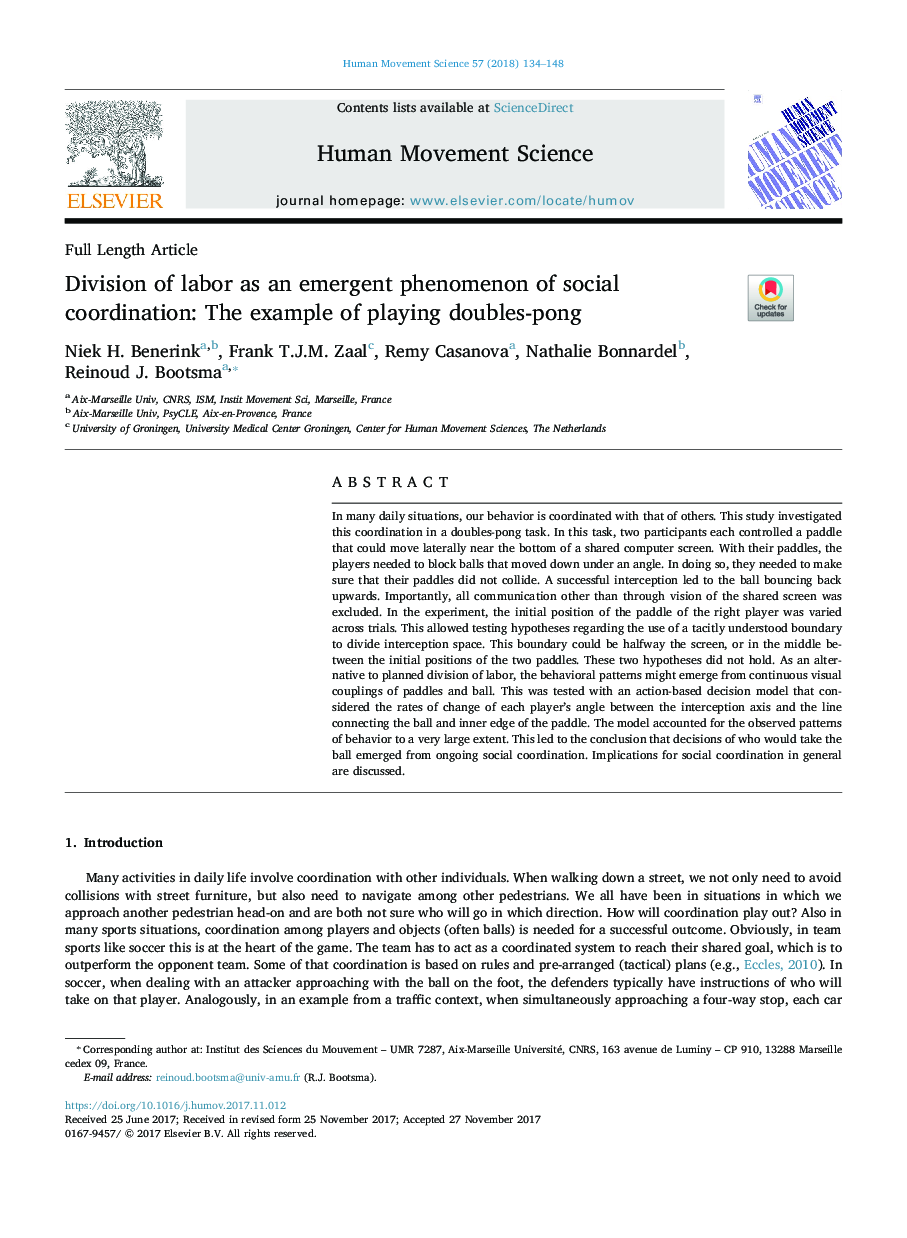| کد مقاله | کد نشریه | سال انتشار | مقاله انگلیسی | نسخه تمام متن |
|---|---|---|---|---|
| 7290951 | 1474207 | 2018 | 15 صفحه PDF | دانلود رایگان |
عنوان انگلیسی مقاله ISI
Division of labor as an emergent phenomenon of social coordination: The example of playing doubles-pong
ترجمه فارسی عنوان
تقسیم کار به عنوان یک پدیده تشدید هماهنگی اجتماعی: مثال بازی دوگانه پنگ
دانلود مقاله + سفارش ترجمه
دانلود مقاله ISI انگلیسی
رایگان برای ایرانیان
ترجمه چکیده
در بسیاری از شرایط روزانه، رفتار ما با دیگران هماهنگ است. این مطالعه این هماهنگی را در یک کار دوبعدی پونگ بررسی کرد. در این وظیفه، دو شرکت کننده هر یک دست و پا زدن را کنترل می کردند که می تواند به سمت پایین در کنار یک صفحه رایانه رایج حرکت کند. با دست و پا زدن آنها، بازیکنان نیاز به مسدود کردن توپ که تحت زاویه حرکت کرد. در انجام این کار، آنها نیاز داشتند تا اطمینان حاصل کنند که دست و پنجه نرم آنها با هم برخورد نمی کردند. رهگیری موفقیت آمیز باعث شد که توپ به سمت بالا بالا برود. مهمتر از همه، تمام ارتباطات غیر از طریق دید از صفحه اشتراکگذاری شده حذف شد. در آزمایش، موقعیت اولیه دست و پا زدن بازیکن راست در سراسر آزمایشات متنوع بود. این اجازه داد که فرضیه های مورد استفاده در مورد استفاده از یک مرز به طور ضمنی درک شده را برای تقسیم فضاهای نگهداری مجاز کند. این مرز می تواند به صورت نیمه راه روی صفحه نمایش باشد، یا در وسط بین موقعیت های اولیه دو دست و پا زدن. این دو فرضیه نداشتند. به عنوان یک جایگزین برای تقسیم کاری برنامه ریزی شده، الگوهای رفتاری ممکن است از همبستگی بصری مداوم از دست و پا زدن و توپ ظاهر شود. این با یک مدل تصمیم گیری مبتنی بر عمل مورد آزمایش قرار گرفت که میزان تغییر زاویه هر بازیکن را بین محور حلقه و خط اتصال توپ و لبه داخلی لامبورگ مورد بررسی قرار داد. این الگو الگوهای رفتار مشاهده شده را به میزان زیادی در بر داشت. این به این نتیجه رسید که تصمیم گیری از کسی که توپ را از هماهنگی جاری در حال پیروی می برد، ظاهر شد. تأثیرات هماهنگی اجتماعی به طور کلی مورد بحث قرار گرفته است.
موضوعات مرتبط
علوم زیستی و بیوفناوری
علم عصب شناسی
علوم اعصاب شناختی
چکیده انگلیسی
In many daily situations, our behavior is coordinated with that of others. This study investigated this coordination in a doubles-pong task. In this task, two participants each controlled a paddle that could move laterally near the bottom of a shared computer screen. With their paddles, the players needed to block balls that moved down under an angle. In doing so, they needed to make sure that their paddles did not collide. A successful interception led to the ball bouncing back upwards. Importantly, all communication other than through vision of the shared screen was excluded. In the experiment, the initial position of the paddle of the right player was varied across trials. This allowed testing hypotheses regarding the use of a tacitly understood boundary to divide interception space. This boundary could be halfway the screen, or in the middle between the initial positions of the two paddles. These two hypotheses did not hold. As an alternative to planned division of labor, the behavioral patterns might emerge from continuous visual couplings of paddles and ball. This was tested with an action-based decision model that considered the rates of change of each player's angle between the interception axis and the line connecting the ball and inner edge of the paddle. The model accounted for the observed patterns of behavior to a very large extent. This led to the conclusion that decisions of who would take the ball emerged from ongoing social coordination. Implications for social coordination in general are discussed.
ناشر
Database: Elsevier - ScienceDirect (ساینس دایرکت)
Journal: Human Movement Science - Volume 57, February 2018, Pages 134-148
Journal: Human Movement Science - Volume 57, February 2018, Pages 134-148
نویسندگان
Niek H. Benerink, Frank T.J.M. Zaal, Remy Casanova, Nathalie Bonnardel, Reinoud J. Bootsma,
